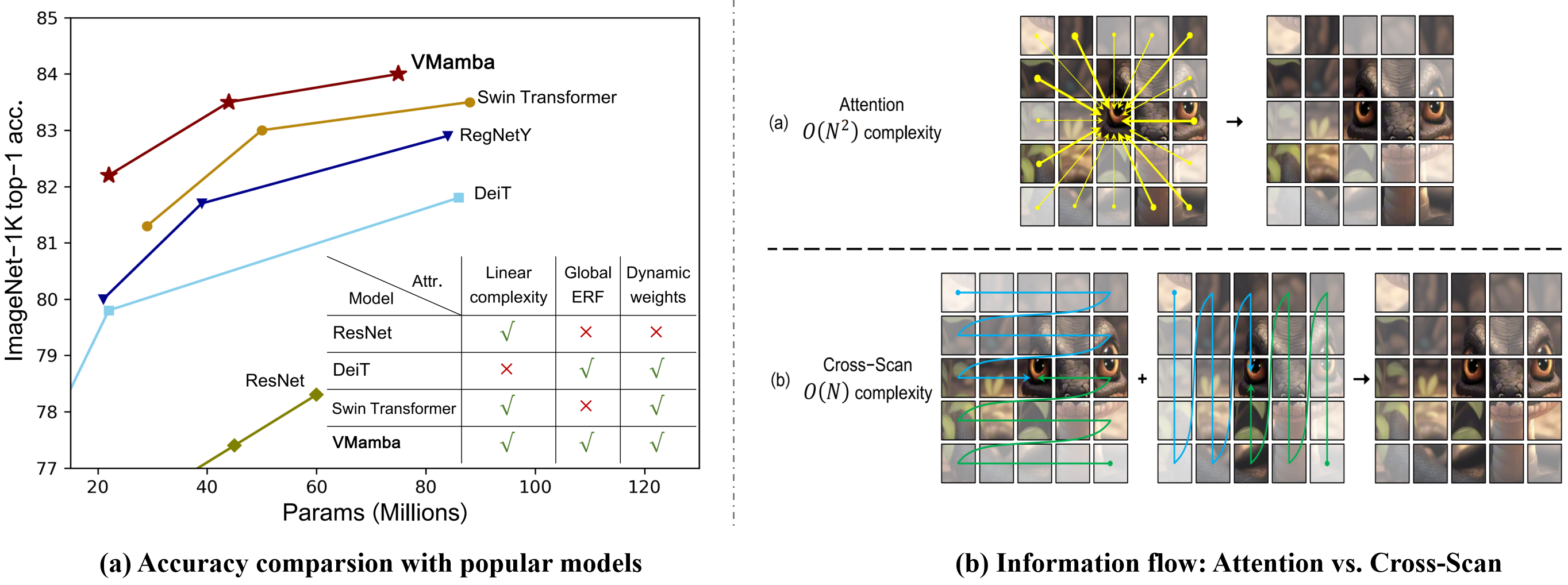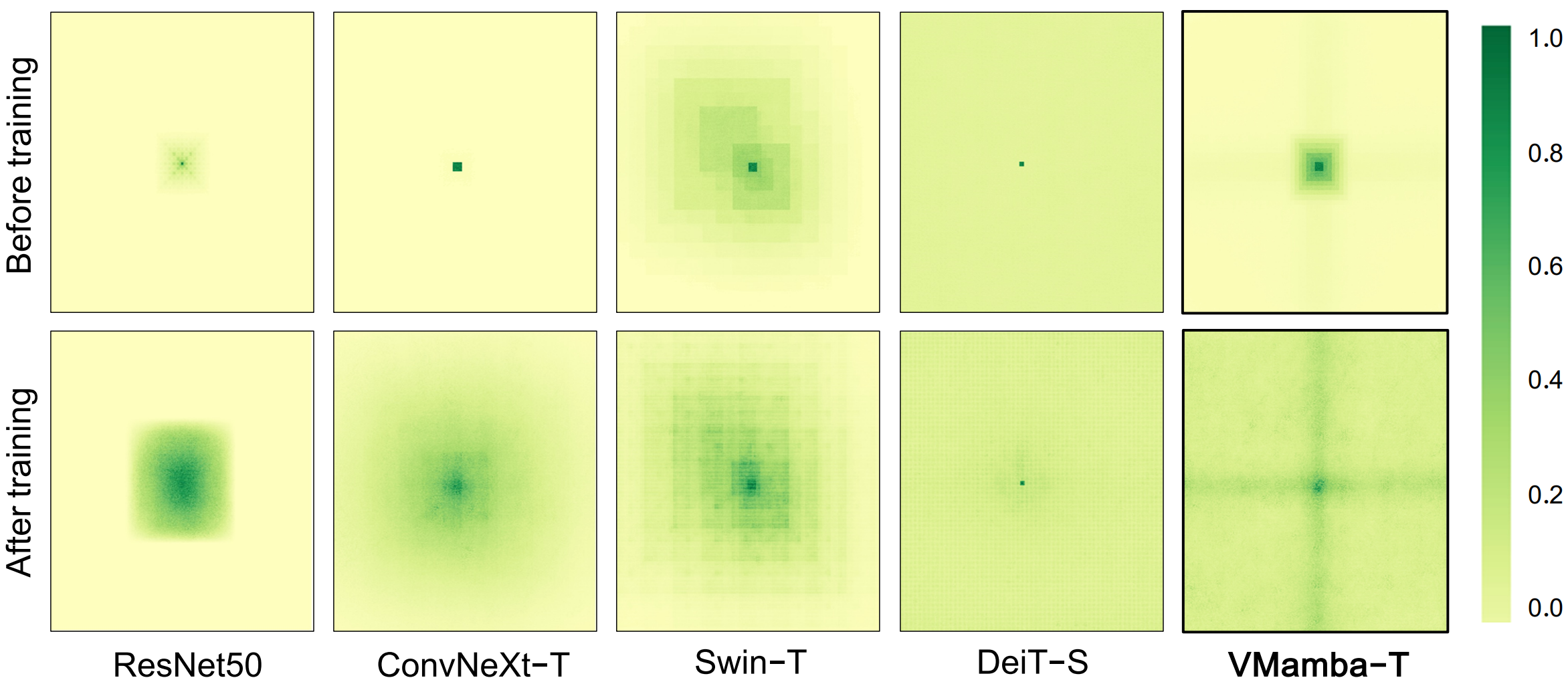Yue Liu1,Yunjie Tian1,Yuzhong Zhao1, Hongtian Yu1, Lingxi Xie2, Yaowei Wang3, Qixiang Ye1, Yunfan Liu1
1 University of Chinese Academy of Sciences, 2 HUAWEI Inc., 3 PengCheng Lab.
Paper: (arXiv 2401.10166)
-
Feb. 1st, 2024: Fix bug: we now calculate FLOPs with the algrithm @albertgu provides, which will be bigger than previous calculation (which is based on theselective_scan_reffunction, and ignores the hardware-aware algrithm). We plan to update tables below later. -
Jan. 31st, 2024: Add feature:selective_scannow supports an extra argumentnrowin[1, 2, 4]. If you find your device is strong and the time consumption keeps asd_staterises, try this feature to speed upnrowsx without any cost ! Note that this feature is actually abug fixfor mamba. -
Jan. 28th, 2024: we cloned main into a new branch called20240128-achieve, the main branch has experienced a great update now. The code now are much easier to use in your own project, and the training speed is faster! This new version is totally compatible with original one, and you can use previous checkpoints without any modification. But if you want to use exactly the same models as original ones, just changeforward_core = self.forward_corev1intoforward_core = self.forward_corev0inclassification/models/vmamba/vmamba.py#SS2Dor you can change into the branch20240128-archiveinstead. -
Jan. 23th, 2024: we add an alternative for mamba_ssm and causal_conv1d. Typingpip install .inselective_scanand you can get rid of those two packages.Just turnThe training speed is expected to raise from 20min/epoch for tiny in 8x4090GPU to 17min/epoch, GPU memory cost reduces too. We have not trained our model with this feature, and we'll try in the future.self.forward_core = self.forward_corev0toself.forward_core = self.forward_corev1inclassification/models/vmamba/vmamba.py#SS2D.__init__to enjoy that feature. -
Jan. 22th, 2024: We have released VMamba-T/S pre-trained weights. The ema weights should be converted before transferring to downstream tasks to match the module names using get_ckpt.py. -
Jan. 19th, 2024: The source code for classification, object detection, and semantic segmentation are provided.
Convolutional Neural Networks (CNNs) and Vision Transformers (ViTs) stand as the two most popular foundation models for visual representation learning. While CNNs exhibit remarkable scalability with linear complexity w.r.t. image resolution, ViTs surpass them in fitting capabilities despite contending with quadratic complexity. A closer inspection reveals that ViTs achieve superior visual modeling performance through the incorporation of global receptive fields and dynamic weights. This observation motivates us to propose a novel architecture that inherits these components while enhancing computational efficiency. To this end, we draw inspiration from the recently introduced state space model and propose the Visual State Space Model (VMamba), which achieves linear complexity without sacrificing global receptive fields. To address the encountered direction-sensitive issue, we introduce the Cross-Scan Module (CSM) to traverse the spatial domain and convert any non-causal visual image into order patch sequences. Extensive experimental results substantiate that VMamba not only demonstrates promising capabilities across various visual perception tasks, but also exhibits more pronounced advantages over established benchmarks as the image resolution increases.
- VMamba serves as a general-purpose backbone for computer vision with linear complexity and shows the advantages of global receptive fields and dynamic weights.
- 2D-Selective-Scan of VMamba
- VMamba has global effective receptive field
We will release all the pre-trained models/logs in few days!
- Classification on ImageNet-1K
| name | pretrain | resolution | acc@1 | #params | FLOPs | checkpoints/logs |
|---|---|---|---|---|---|---|
| DeiT-S | ImageNet-1K | 224x224 | 79.8 | 22M | 4.6G | -- |
| DeiT-B | ImageNet-1K | 224x224 | 81.8 | 86M | 17.5G | -- |
| DeiT-B | ImageNet-1K | 384x384 | 83.1 | 86M | 55.4G | -- |
| Swin-T | ImageNet-1K | 224x224 | 81.2 | 28M | 4.5G | -- |
| Swin-S | ImageNet-1K | 224x224 | 83.2 | 50M | 8.7G | -- |
| Swin-B | ImageNet-1K | 224x224 | 83.5 | 88M | 15.4G | -- |
| VMamba-T | ImageNet-1K | 224x224 | 82.2 | 22M | 4.5G | ckpt/log |
| VMamba-S | ImageNet-1K | 224x224 | 83.5 | 44M | 9.1G | ckpt/log |
| VMamba-B | ImageNet-1K | 224x224 | 84.0 | 75M | 15.2G | waiting |
- Object Detection on COCO
| Backbone | #params | FLOPs | Detector | box mAP | mask mAP | checkpoints/logs |
|---|---|---|---|---|---|---|
| Swin-T | 48M | 267G | MaskRCNN@1x | 42.7 | 39.3 | -- |
| VMamba-T | 42M | 262G | MaskRCNN@1x | 46.5 | 42.1 | ckpt/log |
| Swin-S | 69M | 354G | MaskRCNN@1x | 44.8 | 40.9 | -- |
| VMamba-S | 64M | 357G | MaskRCNN@1x | 48.2 | 43.0 | ckpt/log |
| Swin-B | 107M | 496G | MaskRCNN@1x | 46.9 | 42.3 | -- |
| VMamba-B | 96M | 482G | MaskRCNN@1x | 48.5 | 43.1 | ckpt/log |
| Swin-T | 48M | 267G | MaskRCNN@3x | 46.0 | 41.6 | -- |
| VMamba-T | 42M | 262G | MaskRCNN@3x | 48.5 | 43.2 | ckpt/log |
| Swin-S | 69M | 354G | MaskRCNN@3x | 48.2 | 43.2 | -- |
| VMamba-S | 64M | 357G | MaskRCNN@3x | 49.7 | 44.0 | ckpt/log |
- Semantic Segmentation on ADE20K
| Backbone | Input | #params | FLOPs | Segmentor | mIoU | checkpoints/logs |
|---|---|---|---|---|---|---|
| Swin-T | 512x512 | 60M | 945G | UperNet@160k | 44.4 | -- |
| VMamba-T | 512x512 | 55M | 939G | UperNet@160k | 47.3 | ckpt/log |
| Swin-S | 512x512 | 81M | 1039G | UperNet@160k | 47.6 | -- |
| VMamba-S | 512x512 | 76M | 1037G | UperNet@160k | 49.5 | ckpt/log |
| Swin-B | 512x512 | 121M | 1188G | UperNet@160k | 48.1 | -- |
| VMamba-B | 512x512 | 110M | 1167G | UperNet@160k | 50.0 | ckpt/log |
| Swin-S | 640x640 | 81M | 1614G | UperNet@160k | 47.9 | -- |
| VMamba-S | 640x640 | 76M | 1620G | UperNet@160k | 50.8 | ckpt/log |
step1:Clone the VMamba repository:
To get started, first clone the VMamba repository and navigate to the project directory:
git clone https://github.com/MzeroMiko/VMamba.git
cd VMamba
step2:Environment Setup:
VMamba recommends setting up a conda environment and installing dependencies via pip. Use the following commands to set up your environment:
conda create -n vmamba
conda activate vmambapip install -r requirements.txt
# Install selective_scan and its dependencies
cd selective_scan && pip install . && pytestOptional Dependencies for Model Detection and Segmentation:
pip install mmengine==0.10.1 mmcv==2.1.0 opencv-python-headless ftfy
pip install mmdet==3.3.0 mmsegmentation==1.2.2 mmpretrain==1.2.0Classification:
To train VMamba models for classification on ImageNet, use the following commands for different configurations:
# For VMamba Tiny
python -m torch.distributed.launch --nnodes=1 --node_rank=0 --nproc_per_node=8 --master_addr="127.0.0.1" --master_port=29501 main.py --cfg configs/vssm/vssm_tiny_224.yaml --batch-size 128 --data-path /dataset/ImageNet2012 --output /tmp
# For VMamba Small
python -m torch.distributed.launch --nnodes=1 --node_rank=0 --nproc_per_node=8 --master_addr="127.0.0.1" --master_port=29501 main.py --cfg configs/vssm/vssm_small_224.yaml --batch-size 128 --data-path /dataset/ImageNet2012 --output /tmp
# For VMamba Base
python -m torch.distributed.launch --nnodes=1 --node_rank=0 --nproc_per_node=8 --master_addr="127.0.0.1" --master_port=29501 main.py --cfg configs/vssm/vssm_base_224.yaml --batch-size 128 --data-path /dataset/ImageNet2012 --output /tmp
Detection and Segmentation:
For detection and segmentation tasks, follow similar steps using the appropriate config files from the configs/vssm directory. Adjust the --cfg, --data-path, and --output parameters according to your dataset and desired output location.
VMamba includes tools for analyzing the effective receptive field, FLOPs, loss, and scaling behavior of the models. Use the following commands to perform analysis:
# Analyze the effective receptive field
CUDA_VISIBLE_DEVICES=0 python analyze/get_erf.py > analyze/show/erf/get_erf.log 2>&1
# Analyze FLOPs
CUDA_VISIBLE_DEVICES=0 python analyze/get_flops.py > analyze/show/flops/flops.log 2>&1
# Analyze loss
CUDA_VISIBLE_DEVICES=0 python analyze/get_loss.py
# Further analysis on scaling behavior
python analyze/scaleup_show.py
@article{liu2024vmamba,
title={VMamba: Visual State Space Model},
author={Liu, Yue and Tian, Yunjie and Zhao, Yuzhong and Yu, Hongtian and Xie, Lingxi and Wang, Yaowei and Ye, Qixiang and Liu, Yunfan},
journal={arXiv preprint arXiv:2401.10166},
year={2024}
}
This project is based on Mamba (paper, code), Swin-Transformer (paper, code), ConvNeXt (paper, code), OpenMMLab,
and the analyze/get_erf.py is adopted from replknet, thanks for their excellent works.
- We release Fast-iTPN recently, which reports the best performance on ImageNet-1K at Tiny/Small/Base level models as far as we know. (Tiny-24M-86.5%, Small-40M-87.8%, Base-85M-88.75%)


